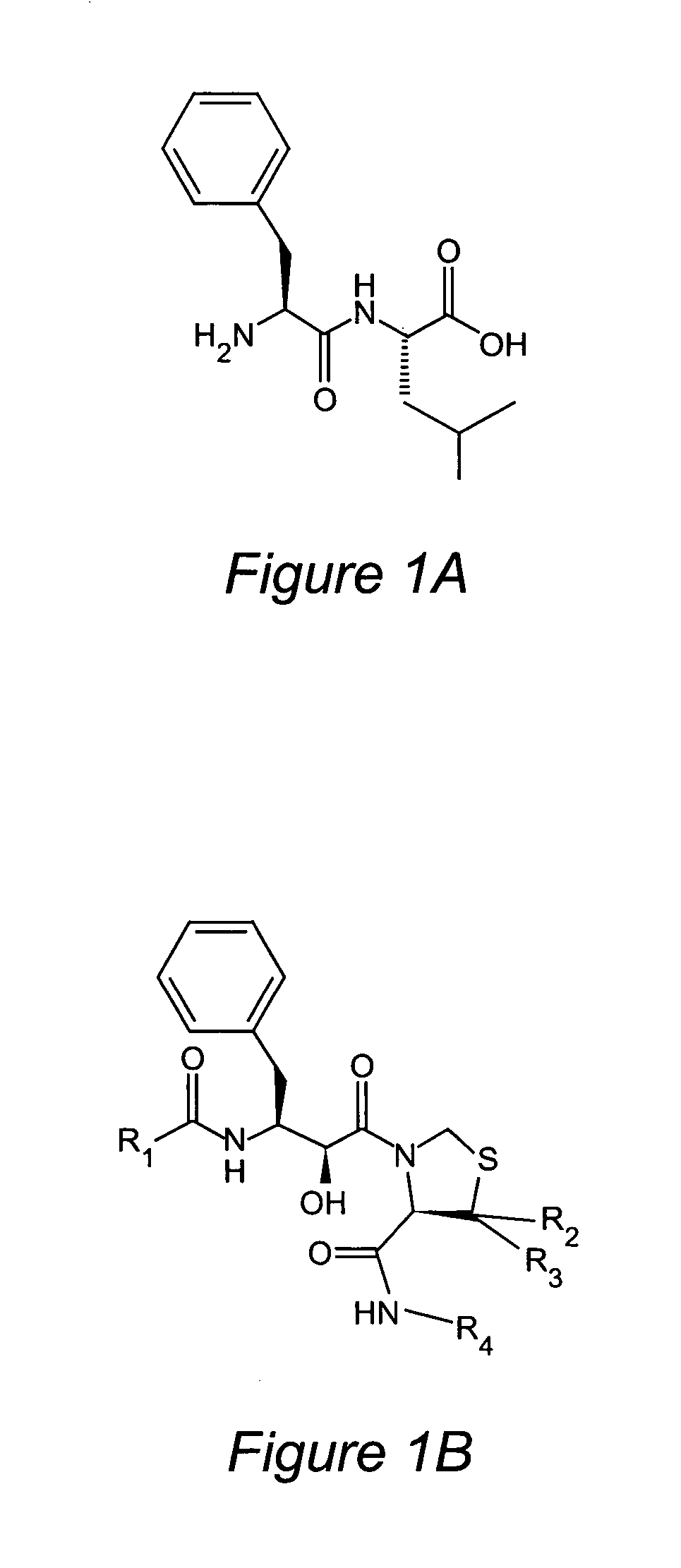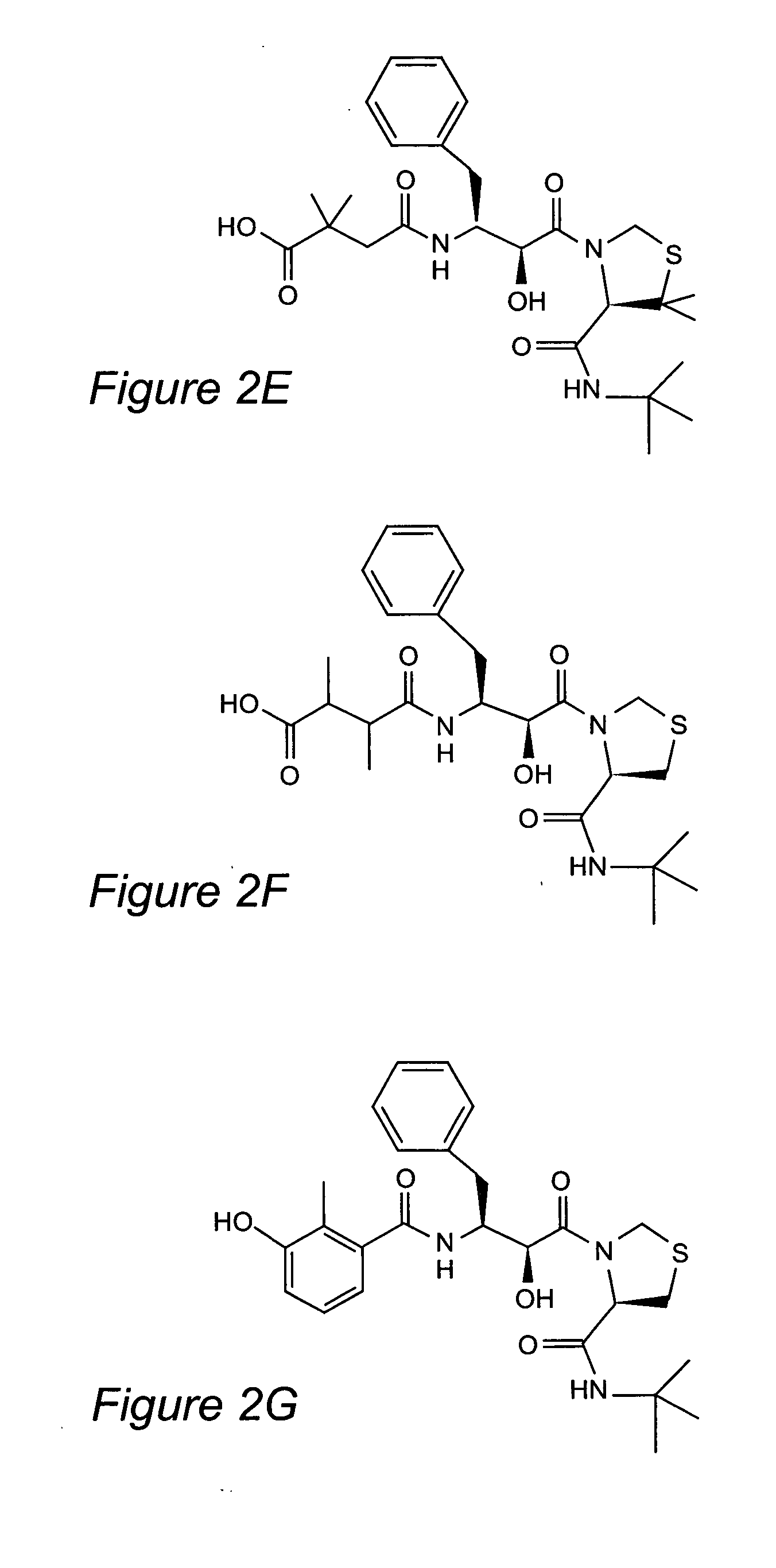Inhibitors of plasmepsins
a technology of plasmepsin and inhibitors, which is applied in the direction of drug compositions, peptide/protein ingredients, peptide sources, etc., can solve the problems of poor selectivity and discrimination versus human aspartic protease, truncated protein that lacks the kinetic properties of native enzymes, and difficult expression and production of active recombinant plasmepsin i
- Summary
- Abstract
- Description
- Claims
- Application Information
AI Technical Summary
Benefits of technology
Problems solved by technology
Method used
Image
Examples
example 1
[0053] The specific activity of plasmepsin II from Plasmodium falciparum (Plm II) cloned in and purified from Escherchia coli and commercially available human Cathepsin D were measured by following the hydrolysis of the chromogenic substrate Ala-Leu-Glu-Arg-Thr-nPhe-Phe-Ser-Phe-Pro-Thr-OH (California Peptide Research Inc., Napa, Calif.). The decrease in absorbance upon hydrolysis is monitored at 300 nm. Typical Plasmepsin II preparations hydrolyze chromogenic substrate at 4-5 s−1 at 37° C. The inhibition assays were performed at 25° C. in 10 mM sodium formate, 2% DMSO, pH 4.0. These pH conditions mimic the conditions in the food vacuole of the parasite. Under the conditions of the assays the Km for plasmepsin II is 20 μM and for human Cathepsin D is 130 μM. Inhibition constants (Ki) for the inhibitors are obtained at the desired temperature and solvent conditions by measuring the rate of substrate hydrolysis at increasing amounts of inhibitors. Exemplary results from three compounds...
example 2
Ratio of Inhibition Constants for Plasmepsin II Versus Cathepsin D
[0055] As described above, it is preferable that the inhibitors display not only strong inhibition of Plasmepsin II, but that they display selectivity for that enzyme. The results of a comparison of inhibition curves for two compounds, KNI-227 and KNI-727, are given in FIGS. 8A and B. Column 4 of Table 2 gives the numerical values of a comparison of the inhibition constants of the indicated KNI-compounds for Plasmepsin 11 versus Cathepsin D. The values given represent the ratio of the Ki for Cathepsin D to the for Plasmepsin II, i.e. the discrimination factor. As can be seen, the selected KNI compounds show a range of from about 2 to about 50 fold selectivity for Plasmepsin II over Cathepsin D.
[0056] This example demonstrates that KNI compounds have the ability to strongly inhibit plasmepsin II while discriminating against Cathepsin D in order to achieve high selectivity.
TABLE 2Comparison of Ki's for Plasmepsin II...
example 3
Evaluation of the Ability of KNI Compounds to Kill the Malaria Parasite
[0057] The ability of some KNI compounds to kill the malaria parasite was evaluated by measuring the IC50 in a malaria-infected human red blood cell assay. Activity was determined by measuring the incorporation of [3H]hypoxanthine. Briefly, chloroquine-sensitive Plasmodium falciparum (NF54) were maintained in a 2.4% suspension of type O+human erythrocytes in RPMI 1640, supplemented with 25 mM HEPES, 27 mM NaHCO3, and 10% heat-inactivated human type O+ serum, under 3% O2, 4% CO2, and 93% N2. 20 mM stock solutions of KNI-764 and KNI-727 and KNI-840 were prepared in DMSODMSO solutions were diluted 500 fold in medium, serially diluted in 0.2% DMSO in medium, then 100 μl aliquots were pipetted into microtiter plate wells. Provisional EC50 values were obtained in a survey of ten 5-fold dilutions yielding final concentrations (in quadruplicate) of 0.00001-20 μM. Plates included 8 wells of no drug controls (4 with and 4...
PUM
| Property | Measurement | Unit |
|---|---|---|
| energy | aaaaa | aaaaa |
| acidic | aaaaa | aaaaa |
| crystallographic structure | aaaaa | aaaaa |
Abstract
Description
Claims
Application Information
 Login to View More
Login to View More - R&D
- Intellectual Property
- Life Sciences
- Materials
- Tech Scout
- Unparalleled Data Quality
- Higher Quality Content
- 60% Fewer Hallucinations
Browse by: Latest US Patents, China's latest patents, Technical Efficacy Thesaurus, Application Domain, Technology Topic, Popular Technical Reports.
© 2025 PatSnap. All rights reserved.Legal|Privacy policy|Modern Slavery Act Transparency Statement|Sitemap|About US| Contact US: help@patsnap.com



